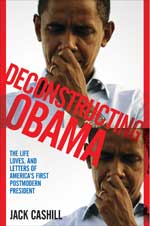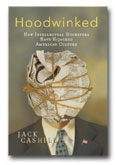How Obama Lost His Postmodern Groove
Get your copy of Deconstructing Obama

___
Jack Cashill's book:
Hoodwinked: How Intellectual Hucksters have Hijacked American Culture

Click here for signed first edition
©Jack Cashill
AmericanThinker.com - January 6, 2012
On December 9, President Barack Obama sat down for a lengthy interview with Steve Croft of 60 Minutes unaided by speechwriters or teleprompters. In the course of it, not surprisingly, he showed himself to be almost as vain and unreflective as the late dear leader, Kim Jong-Il.
Obama put his own accomplishments above those of any president with the “ possible exceptions” of LBJ, FDR, and Lincoln and, as to personal insights, he could only offer up self-serving bromides like, “I'm a persistent son of a gun. I just stay at it.”
Those who got to know Obama through his acclaimed 1995 memoir Dreams from My Father had to be at least a little disappointed. For that one brief shining moment, Obama emerged as an all out, balls-to-the-wall postmodernist, self-absorbed perhaps, but as anguished and introspective as a monk.
Although postmodernism is as hard to define as pornography, postmodernists are not hard to spot. As a rule, they reject the possibility of an objective, universal truth and struggle to “construct” more personalized “narratives” to shape their own lives.
“What I was telling them was a lie,” Obama says in Dreams of an early attempt to define himself, “something I’d constructed from the scraps of information I’d picked up from my mother.” At book’s end, after his journey, he had moved beyond a mere “construct of words” and become the complete person he strove to be.
Curiously. Obama showed no signs of a postmodern style before Dreams and, as evidenced in his 60 Minutes interview, none lately. The reason for his postmodern mayfly moment is not hard to discern. Obama’s mentor Bill Ayers, a sophisticated student of the narrative art, took over Dreams from his struggling protégé and infused it with his own experiences, his own language, and his own postmodern ethos.
Ayers’s memoir, the 2001 Fugitive Days, is laced with repeated reference to what he calls “our constructed reality.” Ayers employs the concept literally, figuratively, and often some place in between. “We constructed our lives underground,” he writes on one occasion. “We invented words; we constructed culture,” he says on another. (For simplicity’s sake, I will refer to “Obama” as the author of everything that appears under his name.)
Ayers’s memoir and Obama’s follow oddly similar rules. Ayers deliberately blurs facts and changes identities and makes no claims at history. “Memory is a delicate dance of desire and faith, a shadow of a shadow, an echo of a sigh. We cheat. We steal. We remember in our favor,” writes Ayers.
Obama says much the same. He acknowledges, “the temptation to color events in ways favorable to the writer, the tendency to overestimate the interest one’s experiences hold for others, selective lapses of memory.” In Dreams too, some characters are composites. Names have been changed. Events occur out of precise chronology
Obama biographer David Remnick cuts Obama slack for Dreams’ "mixture of verifiable fact, recollection, recreation, invention, and artful shaping." What makes the book “exceptional,” he observes, is “not that Obama allows himself these freedoms, but, rather, that he cops to them right away.”
Not that exceptional. Ayers cops to these freedoms right away too. He asks of his own memoir, “Is this then the truth?” He answers, “Not exactly. Although it feels entirely honest to me.” The reader knows that Ayers—with some justification—has much to hide. He senses that Obama does too, but he is never quite sure why.
As a former merchant seaman, Ayers often thought in terms of charts and maps when plotting his way through life, a “journey, not by a tourist, but by a pilgrim.” In Fugitive Days, he yearns for a “mariner's chart of the past” to help navigate, but he knows he and his colleagues must face every day “as free people with neither road maps nor guarantees.” In his book, Race Course, Ayers speaks of “the map of my life, already drawn.”
In the introduction of Dreams, Obama talks of his intended book as “an intellectual journey that I imagined for myself, complete with maps and restpoints and a strict itinerary.” He changed his mind, of course, and settled on “a record of a personal, interior journey--a boy’s search for his father, and through that search a workable meaning for his life as a black American.”
“If he [Obama] wrote a single inspired or imaginative sentence in his many columns, let alone a postmodern reflection, I was unable to find it.”
When Obama leaves Hawaii for college in Los Angeles, he leaves his white kin “at some uncharted border.” From this point on, he himself will be responsible for “charting his way through the world.” He will eventually find his way to Africa, where white encroachment “had redrawn the map of black life.”
In January 2008, Ayers crystallized what he had learned in his career as writer and editor in an essay titled “Narrative Push/Narrative Pull.” The lessons that Ayers offers on the art of the narrative seem to have found their way into Dreams unmolested. The Ayers’s quotes come from this essay unless otherwise specified. Obama quotes come from Dreams:
Ayers:
“The hallmark of writing in the first person is intimacy. . . . But in narrative the universal is revealed through the specific, the general through the particular, the essence through the unique, and necessity is revealed through contingency.”
Obama:
“And so what was a more interior, intimate effort on my part, to understand this struggle and to find my place in it, has converged with a broader public debate, a debate in which I am professionally engaged . . .”
Ayers:
“Narrative begins with something to say—content precedes form.”
Obama:
“I understood that I had spent much of my life trying to rewrite these stories, plugging up holes in the narrative . . . “
Ayers (Fugitive Days):
“We were mostly conformist bores, I thought, unadventurous
in most things, acting out scripts already written.”
Obama:
“I would find myself, at random moments in the day, feeling as if I was living out a preordained script.”
Ayers:
“Narrative inquiry can be a useful corrective to all this.”
Obama:
“Truth is usually the best corrective.”
Ayers:
“The mind works in contradiction, and honesty requires the writer to reveal disputes with herself on the page.”
Obama:
“But I suspect that we can’t pretend that the contradictions of our situation don’t exist. All we can do is choose.”
Ayers:
“Narrative writers strive for a personal signature, but must be aware that the struggle for honesty is constant.”
Obama:
“I was engaged in a fitful interior struggle. I was trying to raise myself to be a black man in America.”
Ayers:
“But that intimacy can trap a writer into a defensive crouch, into airing grievances or self-justification.”
Obama:
“At best, these things were a refuge; at worst, a trap.”
Ayers (Fugitive Days)
Forgetting can be confused with remembering—the fictions we force ourselves to carry replace the facts we are hiding from the world, facts buried within fictions.
Obama
I know how strongly Gramps believed in his fictions, how badly he wanted them to be true, even if he didn’t always know how to make them so.
Ayers (Fugitive Days)
“When history is being rewritten in the interest of a smoother, less troublesome tale . . ..”
Obama
“It corresponds to what I know about my grandfather, his tendency to rewrite his history to conform with the image he wished for himself.”
Ayers (Fugitive Days)
“Go further, we said. Push the limits. Cross the borders.”
Obama
“I drew a series of circles around myself, with borders that shifted as time passed.”
Although I cite no more than two examples for each, Dreams offers many more. There are ten “trap” references alone and nearly as many for “narrative,” “struggle,” “fiction,” and “journey.” With less frequency, the two authors dabble in advanced postmodern slang as well -- the "grooves" into which they have fallen, the "poses" they assume, and even the "stitched together" nature of the lives they or their relatives lead.
Ayers’s style has not changed. Obama’s has—and dramatically. From the publication of Dreams in 1995 to the publication in 2006 of The Audacity of Hope, Obama had nothing in print beyond a semi-regular column in the neighborhood newspaper, the Hyde Park Herald. If he wrote a single inspired or imaginative sentence in his many columns, let alone a postmodern reflection, I was unable to find it.
Audacity presented Obama with another opportunity to reflect on his life’s journey. He did not take it. The postmodern concepts that shape Dreams—memories, narratives, fictions, journeys, struggles, charts, maps, traps, scripts, correctives, contradictions—are either completely absent or used altogether literally.
In Audacity, for instance, Obama writes unremarkably, “ It seems as if I can retrieve only the barest fragments of memory from when I was five.” In Dreams, he addresses a similar concern but with a postmodern flair, “That’s how all the stories went--compact, apocryphal, told in rapid succession in the course of one evening, then packed away for months, sometimes years, in my family’s memory.” Ayers did not write Audacity. He accurately dismissed it as “a political hack book.” Obama did not write it either.
To be sure, there is much additional evidence to support Ayers’s involvement in Dreams. These include the matching 55 or so nautical words or phrases, the identical educational philosophies, the shared use of the Conrad-like triple parallels, the nearly fetishistic eye and eyebrow metaphors, the three stunning parallel stories, the four matching content errors, the same weary 60’s worldview, the borrowed girlfriend in Dreams, the inarguably similar Homeric openings, the dramatically inferior writings of Obama before and after Dreams, the confirmation by Christopher Andersen, and more.
For reasons that escape me, our well-placed friends in conservative literary circles refuse to see what should be obvious to any writer or editor. They refuse to even look. If the Republican candidate comes up a few votes short in November, they will have only themselves to blame.
Webmaster's Note: Jack Cashill's Book-TV presentation of "Deconstructing Obama" can be viewed at http://www.c-spanvideo.org/program/298382-1
Editor's note: For a more complete account of this phenomenon, read Jack Cashill's amazing book, "Hoodwinked: How Intellectual Hucksters Have Hijacked American Culture.

